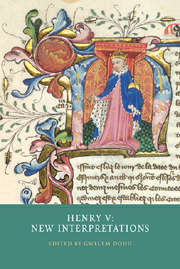Book contents
- Frontmatter
- Dedication
- Contents
- Preface and Acknowledgements
- List of Contributors
- Abbreviations
- Introduction
- 1 The Making of a Prince: The Finances of ‘the young lord Henry’, 1386–1400
- 2 Henry V's Establishment: Service, Loyalty and Reward in 1413
- 3 Henry V, Lancastrian Kingship and the Far North of England
- 4 Henry V's Suppression of the Oldcastle Revolt
- 5 Religion, Court Culture and Propaganda: The Chapel Royal in the Reign of Henry V
- 6 ‘Par le special commandement du roy’. Jewels and Plate Pledged for the Agincourt Expedition
- 7 Henry V and the Cheshire Tax Revolt of 1416
- 8 Henry V and the English Taxpayer
- 9 Henry V, Flower of Chivalry
- 10 War, Government and Commerce: The Towns of Lancastrian France under Henry V's Rule, 1417–22
- 11 Writing History in the Eighteenth Century: Thomas Goodwin's The History of the Reign of Henry the Fifth (1704)
- Index
- York Medieval Press: Publications
7 - Henry V and the Cheshire Tax Revolt of 1416
Published online by Cambridge University Press: 05 July 2013
- Frontmatter
- Dedication
- Contents
- Preface and Acknowledgements
- List of Contributors
- Abbreviations
- Introduction
- 1 The Making of a Prince: The Finances of ‘the young lord Henry’, 1386–1400
- 2 Henry V's Establishment: Service, Loyalty and Reward in 1413
- 3 Henry V, Lancastrian Kingship and the Far North of England
- 4 Henry V's Suppression of the Oldcastle Revolt
- 5 Religion, Court Culture and Propaganda: The Chapel Royal in the Reign of Henry V
- 6 ‘Par le special commandement du roy’. Jewels and Plate Pledged for the Agincourt Expedition
- 7 Henry V and the Cheshire Tax Revolt of 1416
- 8 Henry V and the English Taxpayer
- 9 Henry V, Flower of Chivalry
- 10 War, Government and Commerce: The Towns of Lancastrian France under Henry V's Rule, 1417–22
- 11 Writing History in the Eighteenth Century: Thomas Goodwin's The History of the Reign of Henry the Fifth (1704)
- Index
- York Medieval Press: Publications
Summary
After his triumphal return to England in November 1415, Henry V wasted no time resting on his laurels. He was eager to consolidate his achievements in France, most especially his capture of Harfleur, and to seek opportunities to build on them. His victory at Agincourt provided favourable circumstances for securing the necessary resources. The parliament of November 1415 brought forward the collection of the next instalment of the double subsidy granted in 1414. Early in 1416 he summoned another parliament to meet in March to enable him to secure the necessary resources for a further expedition. As Anne Curry has shown, the mobilization of men and resources in 1416 was on a scale comparable to the Agincourt campaign of 1415 and the expedition of 1417. Though Henry was generally successful in winning support for the war in France, he rapidly became aware of the limits to the nation's capacity and readiness to underwrite his ambitions. All the parliament in March was prepared to concede was another acceleration in the payment of the subsidy already granted in November. Earlier in the month, however, he had made a special effort to secure a subsidy from the palatinate of Chester. With its traditions of soldiering, the county had some investment in the prosecution of the war in France. As earl of Chester since 1399, Henry established close relations with leading knights and squires in Cheshire and in 1415 recruited some 700 Cheshire men for service in France.
- Type
- Chapter
- Information
- Henry VNew Interpretations, pp. 171 - 186Publisher: Boydell & BrewerPrint publication year: 2013



